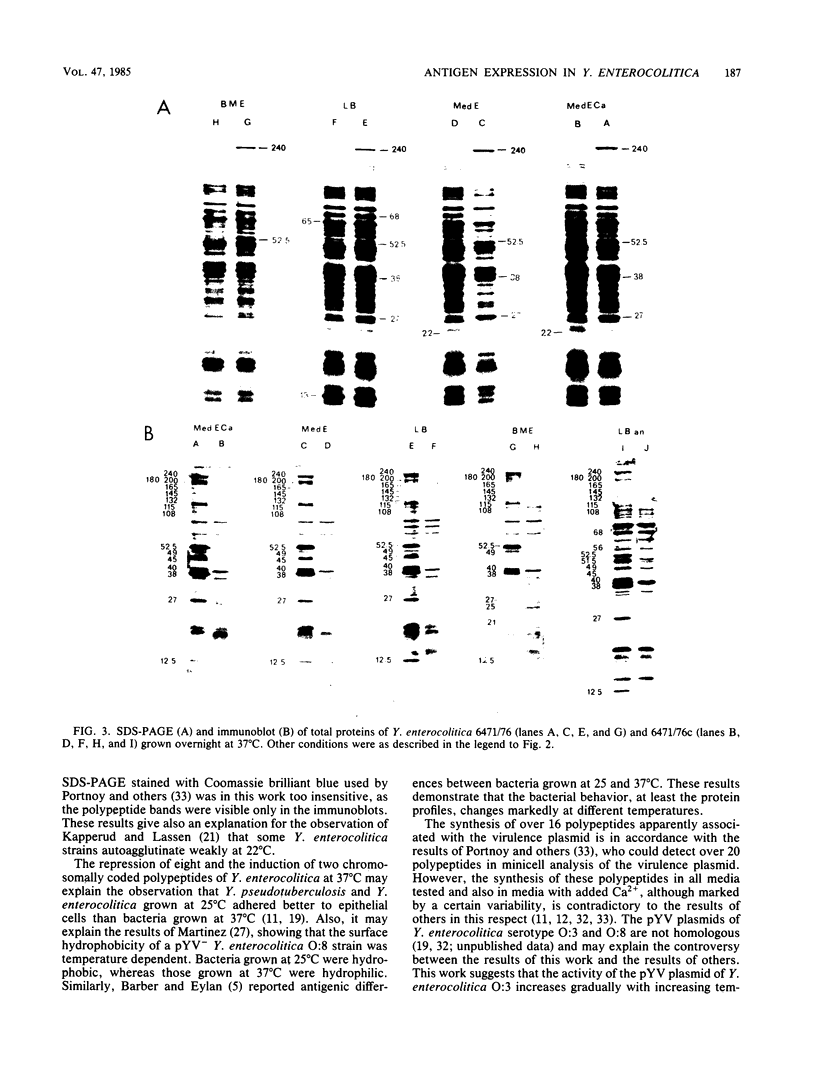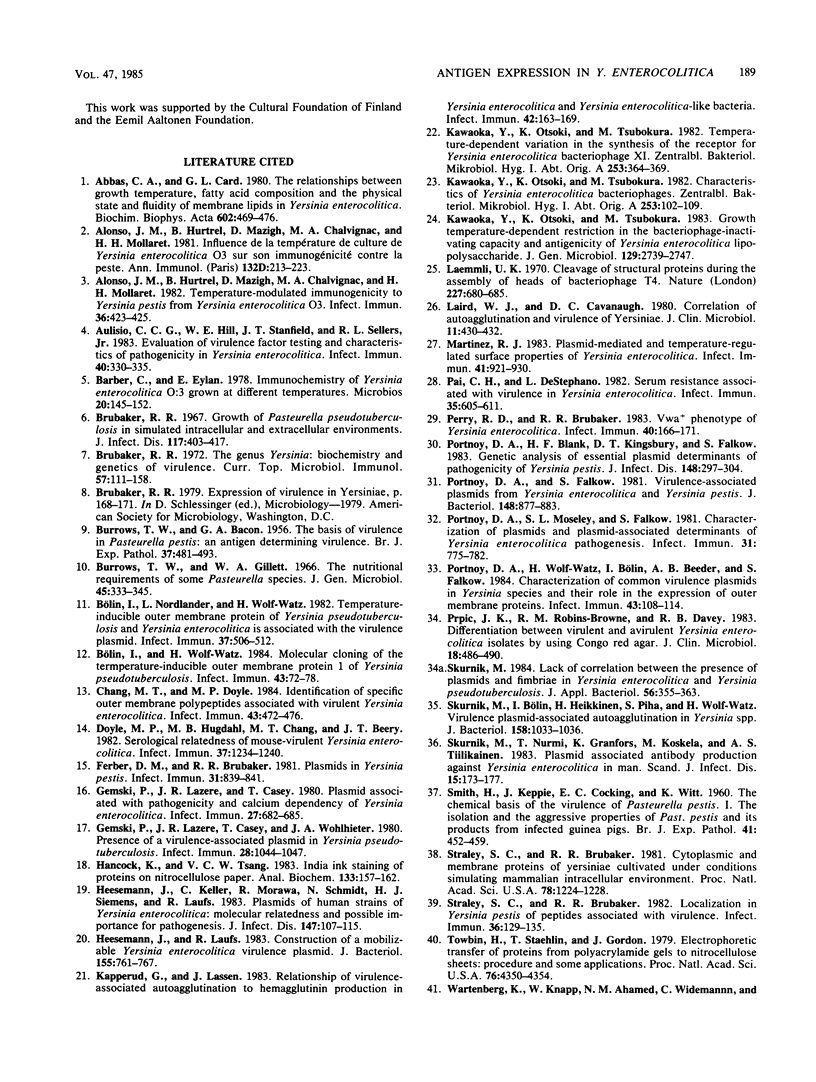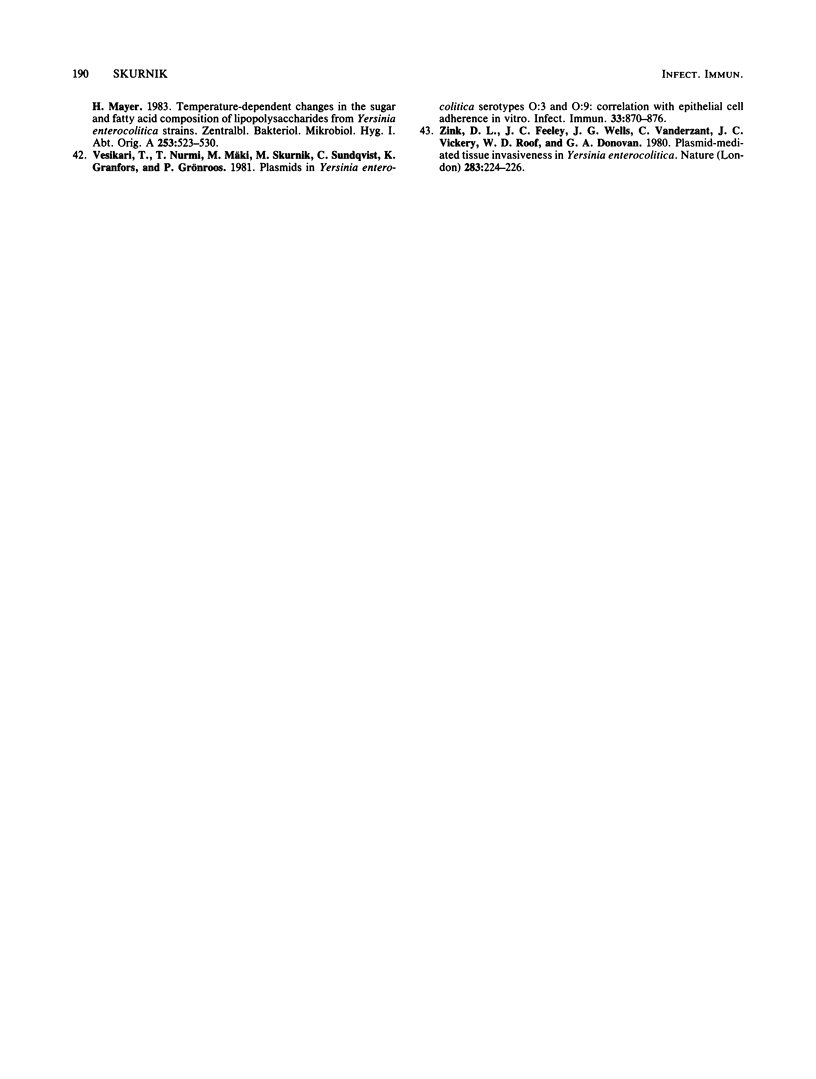Abstract
The expression of polypeptides of the virulence plasmid of Yersinia enterocolitica serotype O:3 was studied with the immunoblotting technique and specifically absorbed antisera to Y. enterocolitica O:3. At least 16 polypeptides were apparently specified by the virulence plasmid when plasmid-bearing bacterial were grown at 37 degrees C or intraperitoneally in semipermeable capsules. The different growth media used (also with added Ca2+) had quantitatively or qualitatively only a little influence on the expression of these polypeptides, whereas the growth temperature had a stronger influence. The best expression was achieved at 37 degrees C, at 22 degrees C the expression was weak, and at 4 degrees C the plasmid genes were inactive. Two chromosomally encoded polypeptides were expressed only at 37 degrees C, whereas the expression of eight polypeptides expressed at 22 degrees C was repressed at 37 degrees C. The intraperitoneal growth in capsules was used to detect the virulence plasmid-associated polypeptides of Yersinia pestis. Four plasmid-associated polypeptides were detected in Y. pestis with antiserum to Y. enterocolitica virulence plasmid antigens, and three were detected with antiserum to Y. pestis EV76. These results suggested that the virulence plasmid of Y. pestis was activated in the interstitial environment in vivo, where Ca2+ concentration was high, and also that the virulence plasmids of Y. enterocolitica and Y. pestis have three to four immunologically related polypeptides in common.
Full text
PDF







Images in this article
Selected References
These references are in PubMed. This may not be the complete list of references from this article.
- Abbas C. A., Card G. L. The relationships between growth temperature, fatty acid composition and the physical state and fluidity of membrane lipids in Yersinia enterocolitica. Biochim Biophys Acta. 1980 Nov 18;602(3):469–476. doi: 10.1016/0005-2736(80)90326-0. [DOI] [PubMed] [Google Scholar]
- Alonso J. M., Hurtrel B., Mazigh D., Chalvignac M. A., Mollaret H. H. Temperature-modulated immunogenicity to Yersinia pestis from Yersinia enterocolitica O3. Infect Immun. 1982 Apr;36(1):423–425. doi: 10.1128/iai.36.1.423-425.1982. [DOI] [PMC free article] [PubMed] [Google Scholar]
- Aulisio C. C., Hill W. E., Stanfield J. T., Sellers R. L., Jr Evaluation of virulence factor testing and characteristics of pathogenicity in Yersinia enterocolitica. Infect Immun. 1983 Apr;40(1):330–335. doi: 10.1128/iai.40.1.330-335.1983. [DOI] [PMC free article] [PubMed] [Google Scholar]
- BACON G. A., BURROWS T. W. The basis of virulence in Pasteurella pestis: an antigen determining virulence. Br J Exp Pathol. 1956 Oct;37(5):481–493. [PMC free article] [PubMed] [Google Scholar]
- Barber C., Eylan E. Immunochemistry of Yersinia enterocolitica O3 grown at different temperatures. Microbios. 1977;20(81-82):145–152. [PubMed] [Google Scholar]
- Brubaker R. R. Growth of Pasteurella pseudotuberculosis in simulated intracellular and extracellular environments. J Infect Dis. 1967 Dec;117(5):403–417. doi: 10.1093/infdis/117.5.403. [DOI] [PubMed] [Google Scholar]
- Brubaker R. R. The genus Yersinia: biochemistry and genetics of virulence. Curr Top Microbiol Immunol. 1972;57:111–158. doi: 10.1007/978-3-642-65297-4_4. [DOI] [PubMed] [Google Scholar]
- Burrows T. W., Gillett W. A. The nutritional requirements of some Pasteurella species. J Gen Microbiol. 1966 Nov;45(2):333–345. doi: 10.1099/00221287-45-2-333. [DOI] [PubMed] [Google Scholar]
- Bölin I., Norlander L., Wolf-Watz H. Temperature-inducible outer membrane protein of Yersinia pseudotuberculosis and Yersinia enterocolitica is associated with the virulence plasmid. Infect Immun. 1982 Aug;37(2):506–512. doi: 10.1128/iai.37.2.506-512.1982. [DOI] [PMC free article] [PubMed] [Google Scholar]
- Bölin I., Wolf-Watz H. Molecular cloning of the temperature-inducible outer membrane protein 1 of Yersinia pseudotuberculosis. Infect Immun. 1984 Jan;43(1):72–78. doi: 10.1128/iai.43.1.72-78.1984. [DOI] [PMC free article] [PubMed] [Google Scholar]
- Chang M. T., Doyle M. P. Identification of specific outer membrane polypeptides associated with virulent Yersinia enterocolitica. Infect Immun. 1984 Feb;43(2):472–476. doi: 10.1128/iai.43.2.472-476.1984. [DOI] [PMC free article] [PubMed] [Google Scholar]
- Doyle M. P., Hugdahl M. B., Chang M. T., Beery J. T. Serological relatedness of mouse-virulent Yersinia enterocolitica. Infect Immun. 1982 Sep;37(3):1234–1240. doi: 10.1128/iai.37.3.1234-1240.1982. [DOI] [PMC free article] [PubMed] [Google Scholar]
- Ferber D. M., Brubaker R. R. Plasmids in Yersinia pestis. Infect Immun. 1981 Feb;31(2):839–841. doi: 10.1128/iai.31.2.839-841.1981. [DOI] [PMC free article] [PubMed] [Google Scholar]
- Gemski P., Lazere J. R., Casey T. Plasmid associated with pathogenicity and calcium dependency of Yersinia enterocolitica. Infect Immun. 1980 Feb;27(2):682–685. doi: 10.1128/iai.27.2.682-685.1980. [DOI] [PMC free article] [PubMed] [Google Scholar]
- Gemski P., Lazere J. R., Casey T., Wohlhieter J. A. Presence of a virulence-associated plasmid in Yersinia pseudotuberculosis. Infect Immun. 1980 Jun;28(3):1044–1047. doi: 10.1128/iai.28.3.1044-1047.1980. [DOI] [PMC free article] [PubMed] [Google Scholar]
- Hancock K., Tsang V. C. India ink staining of proteins on nitrocellulose paper. Anal Biochem. 1983 Aug;133(1):157–162. doi: 10.1016/0003-2697(83)90237-3. [DOI] [PubMed] [Google Scholar]
- Heesemann J., Keller C., Morawa R., Schmidt N., Siemens H. J., Laufs R. Plasmids of human strains of Yersinia enterocolitica: molecular relatedness and possible importance for pathogenesis. J Infect Dis. 1983 Jan;147(1):107–115. doi: 10.1093/infdis/147.1.107. [DOI] [PubMed] [Google Scholar]
- Heesemann J., Laufs R. Construction of a mobilizable Yersinia enterocolitica virulence plasmid. J Bacteriol. 1983 Aug;155(2):761–767. doi: 10.1128/jb.155.2.761-767.1983. [DOI] [PMC free article] [PubMed] [Google Scholar]
- Kapperud G., Lassen J. Relationship of virulence-associated autoagglutination to hemagglutinin production in Yersinia enterocolitica and Yersinia enterocolitica-like bacteria. Infect Immun. 1983 Oct;42(1):163–169. doi: 10.1128/iai.42.1.163-169.1983. [DOI] [PMC free article] [PubMed] [Google Scholar]
- Kawaoka Y., Otsuki K., Tsubokura M. Characteristics of Yersinia enterocolitica bacteriophages. Zentralbl Bakteriol Mikrobiol Hyg A. 1982 Oct;253(1):102–109. [PubMed] [Google Scholar]
- Kawaoka Y., Otsuki K., Tsubokura M. Growth temperature-dependent variation in the bacteriophage-inactivating capacity and antigenicity of Yersinia enterocolitica lipopolysaccharide. J Gen Microbiol. 1983 Sep;129(9):2739–2747. doi: 10.1099/00221287-129-9-2739. [DOI] [PubMed] [Google Scholar]
- Kawaoka Y., Otsuki K., Tsubokura M. Temperature-dependent variation in the synthesis of the receptor for Yersinia enterocolitica bacteriophage XI. Zentralbl Bakteriol Mikrobiol Hyg A. 1982 Dec;253(3):364–369. [PubMed] [Google Scholar]
- Laemmli U. K. Cleavage of structural proteins during the assembly of the head of bacteriophage T4. Nature. 1970 Aug 15;227(5259):680–685. doi: 10.1038/227680a0. [DOI] [PubMed] [Google Scholar]
- Laird W. J., Cavanaugh D. C. Correlation of autoagglutination and virulence of yersiniae. J Clin Microbiol. 1980 Apr;11(4):430–432. doi: 10.1128/jcm.11.4.430-432.1980. [DOI] [PMC free article] [PubMed] [Google Scholar]
- Martinez R. J. Plasmid-mediated and temperature-regulated surface properties of Yersinia enterocolitica. Infect Immun. 1983 Sep;41(3):921–930. doi: 10.1128/iai.41.3.921-930.1983. [DOI] [PMC free article] [PubMed] [Google Scholar]
- Pai C. H., DeStephano L. Serum resistance associated with virulence in Yersinia enterocolitica. Infect Immun. 1982 Feb;35(2):605–611. doi: 10.1128/iai.35.2.605-611.1982. [DOI] [PMC free article] [PubMed] [Google Scholar]
- Perry R. D., Brubaker R. R. Vwa+ phenotype of Yersinia enterocolitica. Infect Immun. 1983 Apr;40(1):166–171. doi: 10.1128/iai.40.1.166-171.1983. [DOI] [PMC free article] [PubMed] [Google Scholar]
- Portnoy D. A., Blank H. F., Kingsbury D. T., Falkow S. Genetic analysis of essential plasmid determinants of pathogenicity in Yersinia pestis. J Infect Dis. 1983 Aug;148(2):297–304. doi: 10.1093/infdis/148.2.297. [DOI] [PubMed] [Google Scholar]
- Portnoy D. A., Falkow S. Virulence-associated plasmids from Yersinia enterocolitica and Yersinia pestis. J Bacteriol. 1981 Dec;148(3):877–883. doi: 10.1128/jb.148.3.877-883.1981. [DOI] [PMC free article] [PubMed] [Google Scholar]
- Portnoy D. A., Moseley S. L., Falkow S. Characterization of plasmids and plasmid-associated determinants of Yersinia enterocolitica pathogenesis. Infect Immun. 1981 Feb;31(2):775–782. doi: 10.1128/iai.31.2.775-782.1981. [DOI] [PMC free article] [PubMed] [Google Scholar]
- Portnoy D. A., Wolf-Watz H., Bolin I., Beeder A. B., Falkow S. Characterization of common virulence plasmids in Yersinia species and their role in the expression of outer membrane proteins. Infect Immun. 1984 Jan;43(1):108–114. doi: 10.1128/iai.43.1.108-114.1984. [DOI] [PMC free article] [PubMed] [Google Scholar]
- Prpic J. K., Robins-Browne R. M., Davey R. B. Differentiation between virulent and avirulent Yersinia enterocolitica isolates by using Congo red agar. J Clin Microbiol. 1983 Sep;18(3):486–490. doi: 10.1128/jcm.18.3.486-490.1983. [DOI] [PMC free article] [PubMed] [Google Scholar]
- Skurnik M. Lack of correlation between the presence of plasmids and fimbriae in Yersinia enterocolitica and Yersinia pseudotuberculosis. J Appl Bacteriol. 1984 Jun;56(3):355–363. doi: 10.1111/j.1365-2672.1984.tb01362.x. [DOI] [PubMed] [Google Scholar]
- Skurnik M., Nurmi T., Granfors K., Koskela M., Tiilikainen A. S. Plasmid associated antibody production against Yersinia enterocolitica in man. Scand J Infect Dis. 1983;15(2):173–177. doi: 10.3109/inf.1983.15.issue-2.08. [DOI] [PubMed] [Google Scholar]
- Straley S. C., Brubaker R. R. Cytoplasmic and membrane proteins of yersiniae cultivated under conditions simulating mammalian intracellular environment. Proc Natl Acad Sci U S A. 1981 Feb;78(2):1224–1228. doi: 10.1073/pnas.78.2.1224. [DOI] [PMC free article] [PubMed] [Google Scholar]
- Straley S. C., Brubaker R. R. Localization in Yersinia pestis of peptides associated with virulence. Infect Immun. 1982 Apr;36(1):129–135. doi: 10.1128/iai.36.1.129-135.1982. [DOI] [PMC free article] [PubMed] [Google Scholar]
- Towbin H., Staehelin T., Gordon J. Electrophoretic transfer of proteins from polyacrylamide gels to nitrocellulose sheets: procedure and some applications. Proc Natl Acad Sci U S A. 1979 Sep;76(9):4350–4354. doi: 10.1073/pnas.76.9.4350. [DOI] [PMC free article] [PubMed] [Google Scholar]
- Vesikari T., Nurmi T., Mäki M., Skurnik M., Sundqvist C., Granfors K., Grönroos P. Plasmids in Yersinia enterocolitica serotypes O:3 and O:9: correlation with epithelial cell adherence in vitro. Infect Immun. 1981 Sep;33(3):870–876. doi: 10.1128/iai.33.3.870-876.1981. [DOI] [PMC free article] [PubMed] [Google Scholar]
- Wartenberg K., Knapp W., Ahamed N. M., Widemann C., Mayer H. Temperature-dependent changes in the sugar and fatty acid composition of lipopolysaccharides from Yersinia enterocolitica strains. Zentralbl Bakteriol Mikrobiol Hyg A. 1983 Feb;253(4):523–530. [PubMed] [Google Scholar]
- Zink D. L., Feeley J. C., Wells J. G., Vanderzant C., Vickery J. C., Roof W. D., O'Donovan G. A. Plasmid-mediated tissue invasiveness in Yersinia enterocolitica. Nature. 1980 Jan 10;283(5743):224–226. doi: 10.1038/283224a0. [DOI] [PubMed] [Google Scholar]







